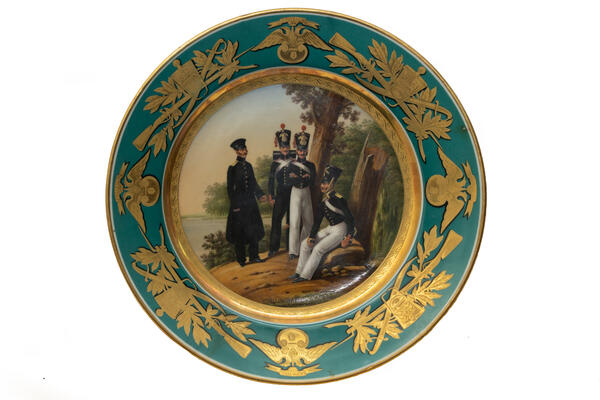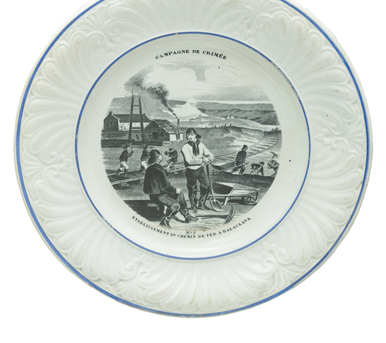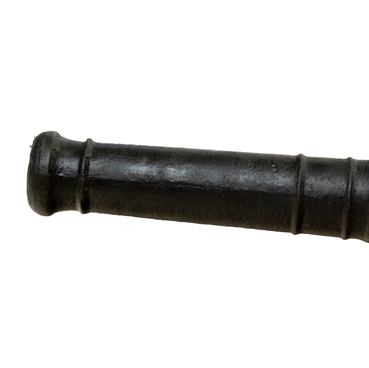The first name of the Imperial Porcelain Factory, which produced a plate from the museum’s collection, was the Nevsky Porcelain Manufactory. In 1744 it was founded during the reign of the Empress Elizaveta Petrovna. The formulas of Russian porcelain, glaze, paints and gold powder for the decoration of porcelain were developed by the chemist Dmitriy Vinogradov. He also independently designed the furnaces, determined the optimal firing conditions and developed molding methods.
Under Vinogradov, the enterprise produced small items: cups, snuff boxes, buttons, brooch inserts, smoking pipes and cane handles. In 1756, a large kiln was built at the factory and began to produce sets, vases and figurines.
In 1779-1796, many series of sculptures were created here, including the “Peoples of Russia”, and the Arabesque service. In 1809-1831, the famous Guryev service and large-sized palace vases appeared.
In the middle and second half of the 19th century, eclecticism prevailed in the works of sculptors and artists of the Imperial Porcelain Factory — a combination of artistic styles from different eras. And at the beginning of the 20th century, the plant began to cooperate with famous artists: Valentin Serov, Konstantin Somov and others. The company produced pieces that have become famous all over the world.
The decorative plate, presented at the exhibition was created at the factory in 1843 and belonged to Alexander Ivanovich Maltsev, a veteran of the defense of Sevastopol in 1854-1855, a lieutenant, company commander of the 17th Yeletsk Infantry Regiment.
The bottom of the plate is decorated with a picture. Against the background of the landscape, the lower ranks of the artillery department are depicted: privates of the artillery battery, reserve parks — artillery bases, the veterinary school and the non-commissioned officer of the technical school. The sketch for this drawing was created by the porcelain artist S. Doladugin.
Along the edges of the plate there are decorative elements: a military headdress — shako, placed against the background of the arms, sword and laurel branches, alternating with the image of the double-headed eagle. Above the eagle is a ribbon with the inscription “For Distinction”. On the reverse side of the plate are the stamp of the Imperial Porcelain Factory (the monogram “H I"[N the first] under the crown), the date “1843” and the artist’s signature.
Under Vinogradov, the enterprise produced small items: cups, snuff boxes, buttons, brooch inserts, smoking pipes and cane handles. In 1756, a large kiln was built at the factory and began to produce sets, vases and figurines.
In 1779-1796, many series of sculptures were created here, including the “Peoples of Russia”, and the Arabesque service. In 1809-1831, the famous Guryev service and large-sized palace vases appeared.
In the middle and second half of the 19th century, eclecticism prevailed in the works of sculptors and artists of the Imperial Porcelain Factory — a combination of artistic styles from different eras. And at the beginning of the 20th century, the plant began to cooperate with famous artists: Valentin Serov, Konstantin Somov and others. The company produced pieces that have become famous all over the world.
The decorative plate, presented at the exhibition was created at the factory in 1843 and belonged to Alexander Ivanovich Maltsev, a veteran of the defense of Sevastopol in 1854-1855, a lieutenant, company commander of the 17th Yeletsk Infantry Regiment.
The bottom of the plate is decorated with a picture. Against the background of the landscape, the lower ranks of the artillery department are depicted: privates of the artillery battery, reserve parks — artillery bases, the veterinary school and the non-commissioned officer of the technical school. The sketch for this drawing was created by the porcelain artist S. Doladugin.
Along the edges of the plate there are decorative elements: a military headdress — shako, placed against the background of the arms, sword and laurel branches, alternating with the image of the double-headed eagle. Above the eagle is a ribbon with the inscription “For Distinction”. On the reverse side of the plate are the stamp of the Imperial Porcelain Factory (the monogram “H I"[N the first] under the crown), the date “1843” and the artist’s signature.



